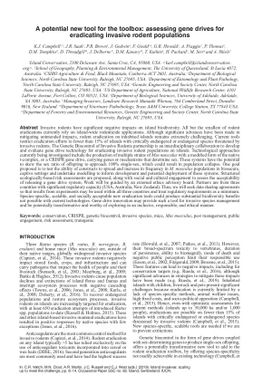A potential new tool for the toolbox: assessing gene drives for eradicating invasive rodent populations
- Description:
- Invasive rodents have significant negative impacts on island biodiversity. All but the smallest of rodent eradications currently rely on island-wide rodenticide applications. Although significant advances have been made in mitigating unintended impacts, rodent eradication on inhabited islands remains extremely challenging. Current tools restrict eradication efforts to fewer than 15% of islands with critically endangered or endangered species threatened by invasive rodents. The Genetic Biocontrol of Invasive Rodents partnership is an interdisciplinary collaboration to develop and evaluate gene drive technology for eradicating invasive rodent populations on islands. Technological approaches currently being investigated include the production of multiple strains of Mus musculus with a modified form of the native t-complex, or a CRISPR gene drive, carrying genes or mechanisms that determine sex. These systems have the potential to skew the sex ratio of off spring to approach 100% single-sex, which could result in population collapse. One goal proposed is to test the ability of constructs to spread and increase in frequency in M. musculus populations in biosecure, captive settings and undertake modelling to inform development and potential deployment of these systems. Structured ecologically-based risk assessments are proposed, along with social and cultural engagement to assess the acceptability of releasing a gene drive system. Work will be guided by an external ethics advisory board. Partners are from three countries with significant regulatory capacity (USA, Australia, New Zealand). Thus, we will seek data sharing agreements so that results from experiments may be used within all three countries and treat regulatory requirements as a minimum. Species-specific, scalable, and socially acceptable new eradication tools could produce substantial biodiversity benefits not possible with current technologies. Gene drive innovation may provide such a tool for invasive species management and be potentially transformative and worthy of exploring in an inclusive, responsible, and ethical manner.
- Display date:
- 2019
- Collections:
- Secretariat of the Pacific Regional Environment Programme (SPREP)
- Publisher:
- International Union for Nature Conservation (IUCN)
- Content partner:
- Secretariat of the Pacific Regional Environment Programme (SPREP)
- Availability:
- Not specified
-
Copyright status: All rights reservedFind out more about what you are able to do with this itemThis item is all rights reserved, with means you'll have to get permission from Secretariat of the Pacific Regional Environment Programme (SPREP) before using it. For more information, please see our use and reuse page.What can I do with this item?Non-infringing useNZ copyright law does not prevent every use of a copyright work, and this item may be hosted by an international institute or organisation. You should consider what you can and cannot do with a copyright work.No sharingYou may not copy and/or share this item with others without further permission. This includes posting it on your blog, using it in a presentation, or any other public use.No modifyingYou are not allowed to adapt or remix this item into any other works.No commercial useYou may not use this item commercially.
Related items
Welcome and warm Pasifik greetings
The information on this site has been gathered from our content partners.
The names, terms, and labels that we present on the site may contain images or voices of deceased persons and may also reflect the bias, norms, and perspective of the period of time in which they were created. We accept that these may not be appropriate today.
If you have any concerns or questions about an item, please contact us.



